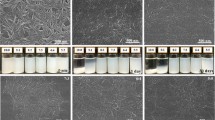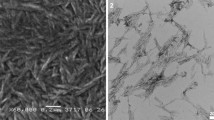Abstract
Carboxymethyl cellulose and TEMPO nanofibrillated cellulose were used as substrates to synthesize copper nanoparticles from copper sulfate and they were subsequently dried using spray-, freeze- and modified freeze-drying processes. Morphological characterization, particle size distribution, copper quantification and the oxidation state of copper were evaluated. The morphology and the size distribution of the dried particles were characterized using scanning electron microscopy-energy dispersive X-ray spectroscopy; particle size distribution was evaluated using laser diffraction; copper content was determined by inductively coupled plasma-optical emission spectroscopy; and finally, the oxidation state of copper was determined using X-ray photoelectron spectroscopy and X-ray diffraction. Plate-like structures of cellulose and cellulose-copper nanoparticles were formed after the freeze-drying process, with length and width over hundreds of microns. Most of the spray dried particles exhibited spherical shapes with the particle size ranging from around 300 nm to several microns. The spray drying process caused more copper loss compared with freeze drying, most probably because of the additional steps required to perform the spray drying. XPS results showed that the state of oxidation of the final dried material depends on the specific substrate. CMC surfaces exhibit mostly Cu0 and/or Cu+. On the contrary TNFC surfaces present mostly Cu2+. Solvent exchange process using ethanol and butanol creates more porous structures on the CMC substrates. A solvent exchange process using ethanol and tert-butanol sequence facilitates the formation of a more porous structure on TEMPO nanofibrillated cellulose.









Similar content being viewed by others
Abbreviations
- CMC:
-
Carboxymethyl cellulose
- TNFC:
-
TEMPO nanofibrillated cellulose
- TEMPO:
-
2,2,6,6-Tetramethylpiperidine-1-oxyl radical
- XPS:
-
X-ray photoelectron spectroscopy
References
Abdelwahed W, Degobert G, Stainmesse S, Fessi H (2006) Freeze-drying of nanoparticles: formulation, process and storage considerations. Adv Drug Deliv Rev 58:1688–1713
Azam A, Ahmed AS, Oves M, Khan MS, Memic A (2012) Size-dependent antimicrobial properties of CuO nanoparticles against Gram-positive and-negative bacterial strains. Int J Nanomed 7:3527–3535
Beeton ML, Aldrich-Wright JR, Bolhuis A (2014) The antimicrobial and antibiofilm activities of copper (II) complexes. J Inorg Biochem 140:167–172
Borchert H, Shevchenko EV, Robert A, Mekis I, Kornowski A, Grubel G, Weller H (2005) Determination of nanocrystal sizes: a comparison of TEM, SAXS, and XRD studies of highly monodisperse CoPts particles. Langmuir 21:1931–1936
Cady N, Behnke JL, Strickland AD (2011) Copper-based nanostructured coatings on natural cellulose: nanocomposites exhibiting rapid and efficient inhibition of a multi-drug resistant wound pathogen, A. baumannii, and mammalian cell biocompatibility in vitro. Adv Funct Mater 21:2506–2514
Chatterjee AK, Chakraborty R, Basu T (2014) Mechanism of antimicrobial activity of copper nanoparticles. Nanotechnology 25:1–12
Djurado E, Bouvier P, Lucazeau G (2000) Crystallite size effect on the tetragonal-monoclinic transition of undoped nanocrystalline zirconia studied by XRD and Raman spectrometry. J Solid State Chem 149:399–407
Eichhorn SJ, Dufresne A, Aranguren M, Marcovich NE, Capadona JR, Rowan SJ, Weder C, Thielemans W, Roman M, Renneckar S, Gindl W, Veigel S, Keckes J, Yano H, Abe K, Nogi M, Nakagaito AN, Mangalam A, Simonsen J, Benight AS, Bismark A, Berglund LA, Peijs T (2010) Review: current international research into cellulose nanofibers and nanocomposites. J Mater Sci 45:1–33
Elanthikkal S, Gopalakrishnapanicker U, Varghese S, Guthrie JT (2010) Cellulose microfibers produced from banana plant wastes: isolation and characterization. Carbohydr Polym 80:852–859
Ferreira T, Rasband W (2012) ImageJ user guide IJ 1.46r. Research Services Branch Web. http://imagej.nih.gov/ij/docs/guide/user-guide.pdf. Accessed 02 Oct 2012
Gardner DJ, Oporto GS, Mills R, Samir MASA (2008) Adhesion and surface issues in cellulose and nanocellulose. J Adhes Sci Technol 22:545–567
Gil M, Vicente J, Gaspar F (2010) Scale-up methodology for pharmaceutical spray drying. Chimica oggi/Chem Today 28(4):18–22
Hou X, Jones BJ (2012) Inductively coupled plasma/optical emission spectrometry. In: Meyers RA (ed) Encyclopedia of analytical chemistry, 1st edn. Wiley, Hoboken, pp 1–17
Hult EL, Larsson PT, Iversen T (2001) Cellulose fibril aggregation-an inherent property of kraft pulps. Polymer 42:3309–3314
Jin H, Nishiyama Y, Wada M, Kuga S (2004) Nanofibrillar cellulose aerogels. Colloids Surf A 240:63–67
Klemm D, Kramer F, Moritz S, Linsdtrom T, Ankerfors M, Gray D, Dorris A (2011) Nanocelluloses: a new family of nature-based materials. Angew Chem Int Ed 50:5438–5466
Liu MS, Lin MCC, Huang IT, Wang CC (2006) Enhancement of thermal conductivity with CuO for nanofluids. Chem Eng Technol 29(1):72–77
Markowicz A (2011) An overview of quantification methods in energy-dispersive X-ray fluorescence analysis. Pramana J Phys 76(2):321–329
Mclntyre NS, Cook MG (1975) X-ray photoelectron studies on some oxides and hydroxides of cobalt, nickel, and copper. Anal Chem 47(13):2208–2213
Nandiyanto ABD, Okuyama K (2011) Progress in developing spray-drying methods for the production of controlled morphology particles: from the nanometer to submicrometer size ranges. Adv Powder Technol 22:1–19
Pakowski Z (2007) Modern methods of drying nanomaterials. Trans Porous Med 66:19–27
Peng Y (2013) Cellulose nanofibrils drying and their utilization in reinforcing thermoplastic composites. Ph.D. Dissertation, University of Maine
Peng Y, Gardner DJ, Han Y (2012a) Drying cellulose nanofibrils: in search of a suitable method. Cellulose 19:91–102
Peng Y, Han Y, Gardner DJ (2012b) Spray-drying cellulose nanofibrils: effect of drying process parameters on particle morphology and size distribution. Wood Fiber Sci 44(4):448–461
Peng Y, Gardner DJ, Han Y, Cai Z, Tshabalala MA (2013a) Influence of drying method on the surface energy of cellulose nanofibrils determined by inverse gas chromatography. J Colloid Interf Sci 405:85–95
Peng Y, Gardner DJ, Han Y, Kiziltas A, Cai Z, Tshabalala MA (2013b) Influence of drying method on the material properties of nanocellulose I: thermostability and crystallinity. Cellulose 20:2379–2392
Rai M, Yadav A, Gade A (2009) Silver nanoparticles as a new generation of antimicrobials. Biotechnol Adv 27:76–83
Sehaqui H, Zhou Q, Berglund LA (2011a) High-porosity aerogels of high specific surface area prepared from nanofibrillated cellulose (NFC). Compos Sci Technol 71:1593–1599
Sehaqui H, Zhou Q, Ikkala O, Berglund LA (2011b) Strong and tough cellulose nanopaper with high specific surface area and porosity. Biomacromolecules 12(10):3638–3644
Stoimenov PK, Klinger RL, Marchin GL, Klabunde KJ (2002) Metal oxide nanoparticles as bactericidal agents. Langmuir 18:6679–6686
Xia X, Xie C, Cai S, Yang Z, Yang X (2006) Corrosion characteristic of copper microparticles and copper nanoparticles in distilled water. Corros Sci 48:3924–3932
Zanchet D, Hall BD, Ugarte D (2000) Structure population in thiol-passivated gold nanoparticles. J Phys Chem B 104:11013–11018
Zhao H, Kwak JH, Zhang ZC, Brown HM, Arey BW, Holladay JE (2007) Studying cellulose fiber structure by SEM, XRD, NMR and acid hydrolysis. Carbohydr Polym 68:235–241
Zhong T, Oporto GS, Jaczynski J, Tesfai AT, Armstrong J (2013) Antimicrobial properties of the hybrid copper nanoparticles-carboxymethyl cellulose. Wood Fiber Sci 45(2):215–222
Acknowledgments
Funding for this work has been provided by NIFA McStennis WVA00098 “Efficient utilization of biomass for biopolymers in central Appalachia”, and USDA NIFA Grant No. 2013-34638-21481 “Development of novel hybrid cellulose nanocomposite film with potent biocide properties utilizing low quality Appalachian hardwoods”. Special thanks to Dr. Weiqiang Ding, from WVU Shared Research Facilities, for his assistance in the XPS, and XRD analyses.
Author information
Authors and Affiliations
Corresponding author
Rights and permissions
About this article
Cite this article
Zhong, T., Oporto, G.S., Peng, Y. et al. Drying cellulose-based materials containing copper nanoparticles. Cellulose 22, 2665–2681 (2015). https://doi.org/10.1007/s10570-015-0646-7
Received:
Accepted:
Published:
Issue Date:
DOI: https://doi.org/10.1007/s10570-015-0646-7




